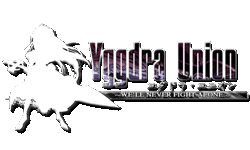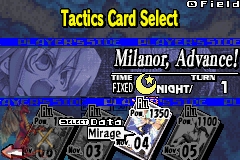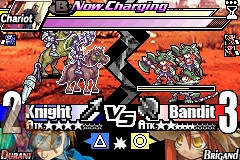|
|

|
BATTLE SYSTEM
|

|
INTERACTION
|

|
ORIGINALITY
|

|
STORY
|

|
MUSIC & SOUND
|

|
VISUALS
|

|
CHALLENGE
|
Medium-Hard
|
COMPLETION TIME
|
35-50 hours
|
|
OVERALL
4.0/5
|
Rating definitions
|
|
|
Though the Game Boy Advance is singing its swan song, there have been a handful of understated but very good titles emerging for the system before it gives its final gasp. One such title is Yggdra Union: We'll Never Fight Alone. A spiritual sequel to Riviera: The Promised Land, the game takes the same artistic style and storytelling magic and plops it down inside of a tactical RPG. With a not quite epic but still enjoyable story, a flexible and challenging battle system, and gorgeous graphics, it's hard to not like the game.
The story seems very uncomplicated at first: a bandit using a princess fleeing for her life for his own purposes. As the story progresses through each chapter, more units join both sides, but it quickly takes over the entire kingdom and beyond. Unlike a typical TRPG where the story is given in giant chunks between battles, Yggdra Union instead staggers objectives and storyline bits within maps as well as between them -- in fact, most of the story is told over the battlefield. The narration between battles merely sets up each battle. There's even good replay value in the story as choices must be made one way or another which changes the story slightly. It is a nice change from the usual and gives a more fluid flow to the story in the game.
The subtitle says it all: there will be no heroes standing alone here. Take to the field with two or more units with Princess Yggdra, and prepare to be almost always outnumbered. But take heart: the battle system isn't simply laid out in its entirety on the first battle. Instead, new aspects of the intricate sytem are laid out within the first dozen or so missions. Battle begins by choosing who will take the field; this choice becomes tougher later as more units join Yggdra's side forcing some to be left behind. Units have Morale which work as Hit Points -- once a unit is drained of Morale, they are defeated and removed from battle. Morale can be recovered with items at this point in the selection screen. Since units lose all experience towards their next level, it is important that units do not perish, especially considering it takes over 30 experience to gain a level, and enemies are only worth two to three. Next, the player chooses the cards they wish to take to battle. Cards have a variety of symbols and numbers on them which will be explained momentarily, but the movement number is key to the beginning stages and many others deeper into the game. The map and enemy units can also be examined at this point. Once units and cards are selected, Yggdra and her army march off to battle.
 Selecting a Card
Selecting a Card
|
|
Battle opens with allies going first followed by the enemies' turn. The player chooses a card to dictate movement. A number is on each card, which represents the total movement all allies can make; thus a card with the number '6' means six different units can move one space each, one unit can move six spaces, three units can move two spaces each, or any combination adding up to six, the number on the card. Later, the Ace of a card is explained, which is a special move that can be performed during battles providing that certain requirements (such as units being the same sex and/or size, a certain time of day, etc) are met. Lastly, there is a symbol which designates which leader must lead the attack for the Ace to be available - that means a card with a wand symbol will only work if the attack is lead by a witch unit. It sounds confusing, but it is laid out step by step within the game. Before or after characters have moved, they can perform a Union -- enter into battle with the enemy. Unions are at first restricted to one unit versus one unit, but later they can grow to contain all of Yggdra's allies if they are positioned correctly. Male units draw their support in an x type pattern, while female units draw their support in a + type pattern. That means a male unit would be supported by a unit one square down and to the right, but a female unit would not. Placing becomes further complicated when supporting units can also draw support based up their patterns -- thus, a male unit can have a female unit in his x, and that female can have a third unit in her +. This allows for large battles, often with four units squaring off on each side. This can create some interesting situations, as players must be careful not to leave one unit open to be overrun by many enemies. Thankfully many bosses leave themselves open to such attacks.
Now the units square off in combat, and a new screen opens up. Ally units are on the left, and enemy units, often designated in red, are on the right. The offense takes a big swing at the defending unit, and the defense gets a chance to strike back. Some units allow for no counters, such as bowmen, and a critical strike will immediately remove a general from the combat round if a unit has one. How well units will fare against each other depends upon their weapons: swords trump axes, axes trump spears, and spears trump swords. Other weapons outside of this triangle exist and have their own properties, such as scythe and rod which trump all three. These weapon strengths and weaknesses are explained in game and can be accessed any time during battle by checking 'Weapon Types' in the menu. Once opening blows are exchanged, the two swing at each other, slowly depleting the other's units. Smaller sized characters such as humanoids begin with six characters in a unit, while larger characters such as knights and golems will begin with three. At the top of the screen is a bar which serves several purposes. Pressing right will force the unit onto the offense and drains the bar. Pressing left will force the unit onto the defense and fills the bar. Later in the game, once a bar is filled the Ace of a card can be activated. These Aces have a variety of uses, from stealing whatever item the enemy holds to causing the enemies to convert to the side of the allies. If a unit is reduced to 0 characters, they lose the skirmish. The winner's card increases in power, and the loser's morale is reduced. The battle system sounds complex, but since it is handed to the player in pieces in order to adjust little by little, it's not as complicated to pick up as it may sound.
As a TRPG is by its very nature based around battling, it is important that the music within these battles be appealing. Unfortunately for Yggdra Union, while these tunes begin as epic and motivating, they eventually begin to sour as battle after battle has the same music behind it. While the rest of the aural repetoire isn't so lacking, the battle music is the one thing which truly drags upon the game. The visuals, on the other hand, are quite stunning. From the cute character sprites to the fully-drawn models, the graphics are a treat and are one of the many excellent reasons to play the game.
 Unit versus Unit Combat
Unit versus Unit Combat
|
|
There's plenty of originality to be found in Yggdra Union. Though card-based battle systems have been done before (Baten Kaitos), it is done differently than seen in other games. Though TRPGs require the predominant playtime to be on the battlefield, it is broken up by tidbits of story where each battle is well explained and justified. The difficulty will vary from chapter to chapter and from mission to mission, but is for the most part neither too hard nor too easy. While the game could be rushed through in as little as 30 hours, a player may find that up to 50 will tick by before they've finished aiding Yggdra and her allies.
With a large variety of menus as well as a storyline which doesn't cut corners, the localization and interface of Yggdra Union would have to be nearly flawless, or the game would sink. Thankfully, both are handled well, and the game shines more for the effort put into it. All menus are easy to access and often only need one button press to display important information vital to a player's success in the game. The translation follows the same trend, with no discernable spelling or grammar errors, and conversations are easy to follow even over different maps and chapters. It is sometimes hard to find a good localization, but Atlus has done a very good job in this regard.
Yggdra Union shows that a game doesn't need to be epic to be enjoyable to play; it also shows that concepts already in RPGs today don't need to be the same old boring way they've always been. With the age of the GBA waning as the DS steadily rises, it's still nice to see a quality game for the former system; after all, a potential sequel done in the same style would certainly have no problems finding a home on the DS. For tactical and strategy veterans, as well as those who have never tried the type of game, all different types of RPGamers will enjoy the title, and it would be a proud feather in anyone's cap to pick up the game and play it repeatedly.
Review Archives
|









